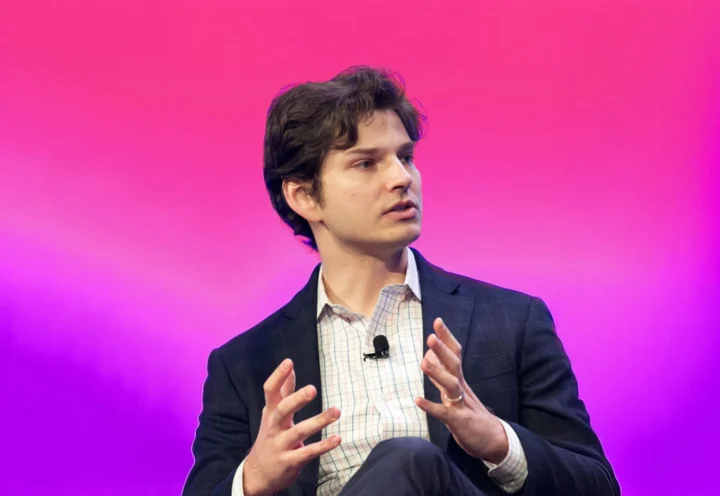The Future of Money Isn’t Human: Lex Sokolin on AI, Crypto, and the Rise of the Autonomous Economy

AI isn’t just analysing markets anymore, it’s learning how to build them. What happens when financial systems start creating themselves?
We asked Lex Sokolin, futurist, investor, and founder of Generative Ventures, to unpack how AI and crypto are quietly merging into a self-driving financial infrastructure.
From algorithmic agents managing liquidity to machines designing financial products, Sokolin outlines why the autonomous economy is already taking shape, even if most of us haven’t noticed yet.
AI as a Foundation of Financial Products
We often hear about AI optimising trading or improving risk models. But what happens when AI starts creating financial products, not just managing existing ones?
That’s actually not a question I hear often, and probably for a reason. We’re still quite far from AI creating financial products.
Today’s “AI-crypto” projects mostly use machine learning to automate strategy switching or improve execution. Think of an agent that moves liquidity between protocols to optimise yield, but the underlying instruments are still human-designed.
What we might see sooner is AI implementing advice: summarising best practices for asset allocation, tax planning, or savings. These qualitative, narrative-driven tasks are already within reach of large language models.
So can these AI agents realistically operate in regulated finance, especially in Europe, where compliance frameworks like MiCA are tightening?
Regulation will shape where innovation happens, not whether it does. Banks and large financial institutions are hyper-compliant, so true experimentation will likely occur outside of them — in crypto ecosystems or jurisdictions with looser oversight.
If you remember, Bitcoin was “illegal” in China multiple times. It didn’t matter. People still used it. The same dynamic will apply to AI agents: innovation first happens in the grey zones, and when it works, banks will either rent it or acquire it.
How do you see crypto and traditional payment systems coexisting, or will one absorb the other?
They’ll fuse.
In the short term, yes, we’re living in a hybrid world. Crypto provides programmability and global reach; traditional finance provides credibility and regulation. But by the time this integration is done, crypto will be inside banks: invisible, boring, and everywhere.
It’s like Apple Pay today. Nobody thinks twice about it, but it’s a miracle of coordination: a supercomputer authenticating your face to connect across multiple payment networks. Crypto will end up as that kind of infrastructure, part of the plumbing.
Right now, stablecoins are at the “military stage.” The commandos, early builders, have survived; now comes operational expansion. Circle is worth $35 billion, and Tether controls half a trillion. The technology isn’t early anymore; the scale-up is.
AI Agents and Payment Systems
There are plenty of quick-payment solutions for merchants — e-commerce, travel, and real estate. Could AI agents fit into these systems somehow?
AI agents aren’t meant to fit in. They’re meant to replace. Legacy payment systems were designed for human interfaces: dashboards, APIs, and KYC screens. AI agents don’t need those. They need protocols. That’s where projects like the Modern Context Protocol (MCP) come in. Instead of websites, we’ll have MCP servers that robots interact with on behalf of humans.
So if you open a sandwich shop, you don’t build a website; you deploy an MCP endpoint where AI agents place orders. That’s the world we’re heading toward.
There won’t be an “AI payment system” as such. AI will use crypto payment systems underneath its economic activity. Agents will pay each other for compute, data, and services.
Stablecoins and blockchain rails are the only structures flexible enough to handle that machine-to-machine commerce.
If AI agents move money autonomously, who carries the risk? The developer? The company? AI itself can’t take legal responsibility, and crypto systems are still vulnerable to hacks.
Exactly, responsibility will sit with the developers and infrastructure providers.
AI can improve security, though. There are startups using machine learning and reinforcement learning to analyse smart contracts and detect vulnerabilities before they’re exploited. But risk never disappears. It’s a capital allocation problem: you spend money on protection; your adversary spends money on attack.
It’s like early e-commerce. People were terrified to use credit cards online because of fraud. Yet, as encryption matured and payment processors like PayPal and Stripe evolved, adoption exploded. The same will happen here. The user experience wins.
At the end of the day, everything in this ecosystem — AI models, blockchains, cryptography — is mathematics. AI infers truth from data; blockchain reaches consensus on truth among participants. The entire economy becomes a network of equations we design.
Where the Autonomous Economy Begins
You’ve been talking about the “autonomous economy” for a while. Do you see it already taking shape?
Absolutely. Over half of all internet traffic today is bots. The majority of trades on exchanges are algorithmic. Social media is filled with automated accounts. We already live in an automated economy; we just don’t notice it.
What’s happening now is convergence.
AI and crypto used to be separate conversations. Today, they’re merging: stablecoin-based payment networks are being built for AI agents.
Even in public markets, automation is obvious. The big AI and tech companies, the Magnificent Seven, have driven nearly all stock market growth over the past two years. We’re watching capital flow to where computation lives.
So yes, the autonomous economy has begun. It’s a matter of scale, not theory.
What kind of projects are you investing in right now that reflect this future?
We back early-stage companies that live at the intersection of AI, crypto, and fintech.
One is PEEAQ, an EVM-compatible layer-1 blockchain built for DePIN — decentralised physical infrastructure. It allows robots, sensors, and machines to have on-chain identities, transact, and even raise capital. It’s literally a blockchain for machines.
Another is Nevermind, which manages AI inference costs. If you ask a model a simple question, it’s cheap; a deep research prompt is expensive. Nevermind automates that billing and pricing logic for AI services.
We also invested in WalletPay, a stablecoin-based payment orchestrator connecting Europe, Africa, and China; Glider, a portfolio automation DeFi app; and MultiLiquid, which helps tokenised real-world asset issuers convert their money-market funds into stablecoins.
Beyond that, we’ve placed smaller checks in decentralised AI infrastructure: Exabits, SuperProtocol, Fraction AI — to learn how decentralised compute and data networks evolve.
Investing in What Comes Next
Looking five years ahead, what kind of financial ecosystem will we live in?
Probably less different than people expect.
If you think back to 2020, not much has changed structurally — just more users, better rails. DeFi’s total locked value might hit a trillion dollars by 2030. Maybe half of the global population will understand how to use wallets. That’s steady, incremental growth.
What matters is direction. Once technology starts compounding, the destination is clear, even if the steps are slow.
By 2035, crypto will be boring — a back-end database that every bank and AI agent uses. By 2050, we might have AIs that own wallets, transact, hire humans, and operate their own corporations. Regulation will chase them, not lead them.
So, for readers who want to keep following your ideas, where can they find you?
They can check out Generative Ventures, and I publish a newsletter called Authentic Blueprint. I’ve been writing it for seven years now about the future of automation, finance, and technology.
In a world where over half of all online interactions already happen between machines, Sokolin confirms that the “autonomous economy” is a logical continuation of financial automation, not a sci-fi prediction. Crypto provides the rails. AI provides the intelligence. The rest is just catching up.












